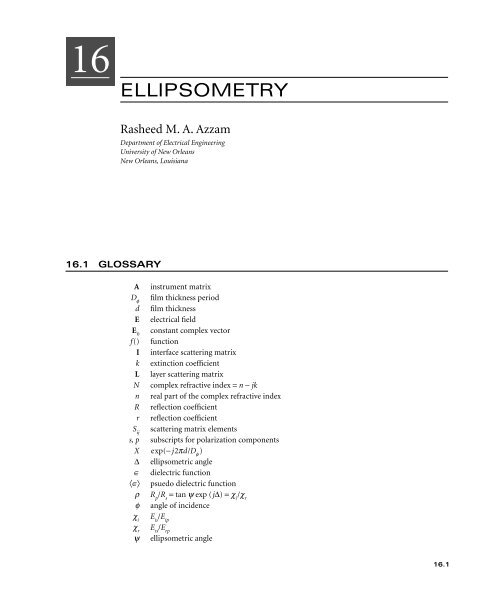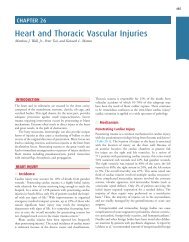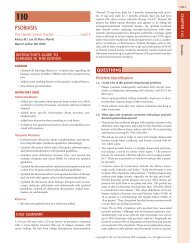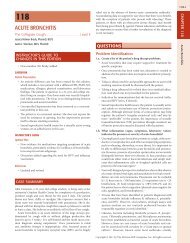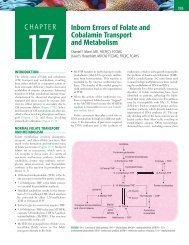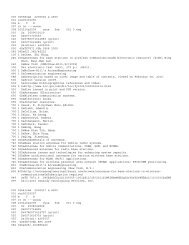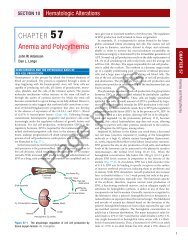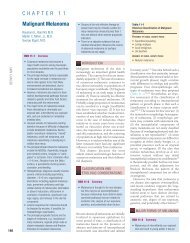ELLIPSOMETRY
ELLIPSOMETRY
ELLIPSOMETRY
You also want an ePaper? Increase the reach of your titles
YUMPU automatically turns print PDFs into web optimized ePapers that Google loves.
16 <strong>ELLIPSOMETRY</strong><br />
16.1 GLOSSARY<br />
Rasheed M. A. Azzam<br />
Department of Electrical Engineering<br />
University of New Orleans<br />
New Orleans, Louisiana<br />
A instrument matrix<br />
Dφ film thickness period<br />
d film thickness<br />
E electrical field<br />
E constant complex vector<br />
0<br />
f() function<br />
I interface scattering matrix<br />
k extinction coefficient<br />
L layer scattering matrix<br />
N complex refractive index = n − jk<br />
n real part of the complex refractive index<br />
R reflection coefficient<br />
r reflection coefficient<br />
S scattering matrix elements<br />
ij<br />
s, p subscripts for polarization components<br />
X exp( − j2πd/ D ) φ<br />
D ellipsometric angle<br />
Πdielectric function<br />
〈 ∈ 〉 psuedo dielectric function<br />
r R /R = tan y exp (jD) = c /c p s i r<br />
f angle of incidence<br />
c E /E i is ip<br />
c E /E r rs rp<br />
y ellipsometric angle<br />
16.1
16.2 POLaRIzEd LIghT<br />
16.2 INTRODUCTION<br />
Ellipsometry is a nonperturbing optical technique that uses the change in the state of polarization<br />
of light upon reflection for the in-situ and real-time characterization of surfaces, interfaces, and<br />
thin films. In this chapter we provide a brief account of this subject with an emphasis on modeling<br />
and instrumentation. For extensive coverage, including applications, the reader is referred to several<br />
monographs, 1–4 handbook, 5 collected reprints, 6 conference proceedings, 7–15 and general and topical<br />
reviews. 16–32<br />
In ellipsometry, a collimated beam of monochromatic or quasi-monochromatic light, which<br />
is polarized in a known state, is incident on a sample surface under examination, and the state of<br />
polarization of the reflected light is analyzed. From the incident and reflected states of polarization,<br />
ratios of complex reflection coefficients of the surface for the incident orthogonal linear polarizations<br />
parallel and perpendicular to the plane of incidence are determined. These ratios are subsequently<br />
related to the structural and optical properties of the ambient-sample interface region by invoking an<br />
appropriate model and the electromagnetic theory of reflection. Finally, model parameters of interest<br />
are determined by solving the resulting inverse problem.<br />
In ellipsometry, one of the two copropagating orthogonally polarized waves can be considered<br />
to act as a reference for the other. Inasmuch as the state of polarization of light is determined by<br />
the superposition of the orthogonal components of the electric field vector, an ellipsometer may be<br />
thought of as a common-path polarization interferometer. And because ellipsometry involves only<br />
relative amplitude and relative phase measurements, it is highly accurate. Furthermore, its sensitivity<br />
to minute changes in the interface region, such as the formation of a submonolayer of atoms or molecules,<br />
has qualified ellipsometry for many applications in surface science and thin-film technologies.<br />
In a typical scheme, Fig. 1, the incident light is linearly polarized at a known but arbitrary azimuth<br />
and the reflected light is elliptically polarized. Measurement of the ellipse of polarization of<br />
the reflected light accounts for the name ellipsometry, which was first coined by Rothen. 33 (For a<br />
discussion of light polarization, the reader is referred to Chap. 12 in this volume. For a historical<br />
background on ellipsometry, see Rothen 34 and Hall. 35 )<br />
For optically isotropic structures, ellipsometry is carried out only at oblique incidence. In this<br />
case, if the incident light is linearly polarized with the electric vector vibrating parallel p or perpendicular<br />
s to the plane of incidence, the reflected light is likewise p- and s-polarized, respectively. In<br />
other words, the p and s linear polarizations are the eigenpolarizations of reflection. 36 The associated<br />
eigenvalues are the complex amplitude reflection coefficients R p and R s . For an arbitrary input<br />
state with phasor electric-field components E ip and E is , the corresponding field components of the<br />
reflected light are given by<br />
p<br />
q<br />
s<br />
E i<br />
E = R E E = RE<br />
(1)<br />
rp p ip rs s is<br />
f<br />
FIGURE 1 Incident linearly polarized light of arbitrary azimuth q is reflected from the surface S<br />
as elliptically polarized. p and s identify the linear polarization directions parallel and perpendicular to<br />
the plane of incidence and form a right-handed system with the direction of propagation. f is the angle<br />
of incidence.<br />
S<br />
E r<br />
s<br />
p
By taking the ratio of the respective sides of these two equations, one gets<br />
where<br />
<strong>ELLIPSOMETRY</strong> 16.3<br />
ρ= χ / χ<br />
(2)<br />
i r<br />
ρ = R / R<br />
(3)<br />
p s<br />
χ = E / E χ = E / E<br />
(4)<br />
i is ip r rs rp<br />
c i and c r of Eqs. (4) are complex numbers that succinctly describe the incident and reflected polarization<br />
states of light; 37 their ratio, according to Eqs. (2) and (3), determines the ratio of the complex<br />
reflection coefficients for the p and s polarizations. Therefore, ellipsometry involves pure polarization<br />
measurements (without account for absolute light intensity or absolute phase) to determine<br />
r. It has become customary in ellipsometry to express r in polar form in terms of two ellipsometric<br />
angles y and D(0 ≤ y ≤ 90°, 0 ≤ D < 360°) as follows<br />
ρ= tanψ exp( jD )<br />
(5)<br />
tan ψ = | R |/| R | p s represents the relative amplitude attenuation and D= arg( R ) − arg( R )<br />
ferential phase shift of the p and s linearly polarized components upon reflection.<br />
Regardless of the nature of the sample, r is a function,<br />
p s is the dif-<br />
ρ= f ( φ, λ)<br />
(6)<br />
of the angle of incidence f and the wavelength of light l. Multiple-angle-of-incidence<br />
ellipsometry 38–43 (MAIE) involves measurement of r as a function of f, and spectroscopic<br />
ellipsometry 3,22,27–31 (SE) refers to the measurement of r as a function of l. In variable-angle spectroscopic<br />
ellipsometry 43 (VASE) the ellipsometric function r of the two real variables f and l is<br />
recorded.<br />
16.3 CONVENTIONS<br />
The widely accepted conventions in ellipsometry are those adopted at the 1968 Symposium on<br />
Recent Developments in Ellipsometry following discussions of a paper by Muller. 44 Briefly, the electric<br />
field of a monochromatic plane wave traveling in the direction of the z axis is taken as<br />
E= E exp( −j2πNz/<br />
λ)exp( jωt) (7)<br />
0<br />
where E 0 is a constant complex vector that represents the transverse electric field in the z = 0 plane,<br />
N is the complex refractive index of the optically isotropic medium of propagation, w is the angular<br />
frequency, and t is the time. N is written in terms of its real and imaginary parts as<br />
N = n− jk<br />
(8)<br />
where n > 0 is the refractive index and k ≥ 0 is the extinction coefficient. The positive directions<br />
of p and s before and after reflection form a right-handed coordinate system with the directions of<br />
propagation of the incident and reflected waves, Fig. 1. At normal incidence (f = 0), the p directions<br />
in the incident and reflected waves are antiparallel, whereas the s directions are parallel. Some of the<br />
consequences of these conventions are as follows:<br />
1. At normal incidence, R = − R , r = − 1, and D = p.<br />
p s<br />
2. At grazing incidence, R = R , r = 1, and D = 0.<br />
p s<br />
3. For an abrupt interface between two homogeneous and isotropic semi-infinite media, D is in the<br />
range 0 ≤ D ≤ p, and 0 ≤ y ≤ 45°.
16.4 POLaRIzEd LIghT<br />
0<br />
0<br />
As an example, Fig. 2 shows y and D vs. f for light reflection at the air/Au interface, assuming<br />
N = 0.306 − j2.880 for Au 45 at l = 564 nm.<br />
16.4 MODELING AND INVERSION<br />
∆<br />
180<br />
150<br />
120<br />
90<br />
60<br />
30<br />
y<br />
15 30 45<br />
f<br />
The following simplifying assumptions are usually made or implied in conventional ellipsometry:<br />
(1) the incident beam is approximated by a monochromatic plane wave; (2) the ambient or incidence<br />
medium is transparent and optically isotropic; (3) the sample surface is a plane boundary;<br />
(4) the sample (and ambient) optical properties are uniform laterally but may change in the direction<br />
of the normal to the ambient-sample interface; (5) the coherence length of the incident light<br />
is much greater than its penetration depth into the sample; and (6) the light-sample interaction is<br />
linear (elastic), hence frequency-conserving.<br />
Determination of the ratio of complex reflection coefficients is rarely an end in itself. Usually,<br />
one is interested in more fundamental information about the sample than is conveyed by r. In<br />
particular, ellipsometry is used to characterize the optical and structural properties of the interfacial<br />
region. This requires that a stratified-medium model (SMM) for the sample under measurement<br />
be postulated that contains the sample physical parameters of interest. For example, for<br />
visible light, a polished Si surface in air may be modeled as an optically opaque (semi-infinite)<br />
Si substrate which is covered with a SiO 2 film, with the Si and SiO 2 phases assumed uniform, and<br />
the air/SiO 2 and SiO 2 /Si interfaces considered as parallel planes. This is often referred to as the<br />
three-phase model. More complexity (and more layers) can be built into this basic SMM to represent<br />
such finer details as the interfacial roughness and phase mixing, a damage surface layer on<br />
Si caused by polishing, or the possible presence of an outermost contamination film. Effective<br />
medium theories 46–54 (EMTs) are used to calculate the dielectric functions of mixed phases based<br />
on their microstructure and component volume fractions; and the established theory of light<br />
reflection by stratified structures 55–60 is employed to calculate the ellipsometric function for an<br />
assumed set of model parameters. Finally, values of the model parameters are sought that best<br />
match the measured and computed values of r. Extensive data (obtained, e.g., using VASE) is<br />
required to determine the parameters of more complicated samples. The latter task, called the<br />
∆<br />
60 75 90 42<br />
FIGURE 2 Ellipsometric parameters y and D of an<br />
air/Au interface as functions of the angle of incidence<br />
f. The complex refractive index of Au is assumed to be<br />
0.306 – j2.880 at 564-nm wavelength. y, D, and f are in<br />
degrees.<br />
46<br />
45<br />
44<br />
43<br />
y
<strong>ELLIPSOMETRY</strong> 16.5<br />
inverse problem, usually employs linear regression analysis, 61–63 which yields information on<br />
parameter correlations and confidence limits. Therefore, the full practice of ellipsometry involves,<br />
in general, the execution and integration of three tasks: (1) polarization measurements that yield<br />
ratios of complex reflection coefficients, (2) sample modeling and the application of electromagnetic<br />
theory to calculate the ellipsometric function, and (3) solving the inverse problem to determine<br />
model parameters that best match the experimental and theoretically calculated values of<br />
the ellipsometric function.<br />
Confidence in the model is established by showing that complete spectra can be described in<br />
terms of a few wavelength-independent parameters, or by checking the predictive power of the<br />
model in determining the optical properties of the sample under new experimental conditions. 27<br />
The Two-Phase Model<br />
For a single interface between two homogeneous and isotropic media, 0 and 1, the reflection coefficients<br />
are given by the Fresnel formulas 1<br />
in which<br />
r = ( ∈ S − ∈ S )/( ∈ S + ∈ S )<br />
(9)<br />
01p 1 0 0 1 1 0 0 1<br />
r = ( S − S ) / ( S + S )<br />
(10)<br />
01s 0 1 0 1<br />
2 ∈ = N i=<br />
01<br />
i i<br />
, (11)<br />
is the dielectric function (or dielectric constant at a given wavelength) of the ith medium,<br />
S i i<br />
= ( − sin ) / 2 1 2<br />
∈ ∈ φ (12)<br />
0<br />
and f is the angle of incidence in medium 0 (measured from the interface normal). The ratio of<br />
complex reflection coefficients which is measured by ellipsometry is<br />
2 1/<br />
2 2 /<br />
ρ= [sinφ tan φ−( ∈− sin φ) ][sin / φ tan φ+<br />
( ∈−sin<br />
φφ) ]<br />
where ∈= ∈/ ∈ . Solving Eq. (13) for Œ gives<br />
1 0<br />
12 (13)<br />
2 2 2 2<br />
∈= ∈ {sin φ+ sin φ tan φ[( 1− ρ)/( 1+<br />
ρ )]}<br />
(14)<br />
1 0<br />
For light incident from a medium (e.g., vacuum, air, or an inert ambient) of known Π, Eq. (14)<br />
0<br />
determines, concisely and directly, the complex dielectric function Πof the reflecting second<br />
1<br />
medium in terms of the measured r and the angle of incidence f. This accounts for an important<br />
application of ellipsometry as a means of determining the optical properties (or optical constants) of<br />
bulk absorbing materials and opaque films. This approach assumes the absence of a transition layer<br />
or a surface film at the two-media interface. If such a film exists, ultrathin as it may be, Πas deter-<br />
1<br />
mined by Eq. (14) is called the pseudo dielectric function and is usually written as 〈 ∈ 〉 1 . Figure 3<br />
shows lines of constant y and lines of constant D in the complex Œ plane at φ = 75°.<br />
The Three-Phase Model<br />
This often-used model, Fig. 4, consists of a single layer, medium 1, of parallel-plane boundaries<br />
which is surrounded by two similar or dissimilar semi-infinite media 0 and 2. The complex amplitude<br />
reflection coefficients are given by the Airy-Drude formula 64,65<br />
R= ( r + r X)/( 1+<br />
r r X) ν = p, s<br />
01ν 12ν 01ν 12ν<br />
(15)<br />
X = exp[ −j2π(<br />
dD / )] φ<br />
(16)
16.6 POLaRIzEd LIghT<br />
e i<br />
–30 –20 –10<br />
er 0 10 20 30<br />
0<br />
tan y = 0.9<br />
∆ = 165°<br />
–10<br />
–20<br />
–30<br />
–40<br />
–50<br />
–60<br />
0.8<br />
0.7<br />
r ijn is the Fresnel reflection coefficient of the ij interface (ij = 01 and 12) for the n polarization, d is the<br />
layer thickness, and<br />
D = ( λ/<br />
2)( 1/ S )<br />
(17)<br />
1<br />
φ<br />
where l is the vacuum wavelength of light and S 1 is given by Eq. (12). The ellipsometric function of<br />
this system is<br />
2 2<br />
ρ = ( A+ BX+ CX ) / ( D+ EX + FX )<br />
(18)<br />
A= r B= r + r r r C= r r r<br />
D= r<br />
0.6<br />
105°<br />
120°<br />
90°<br />
0.5<br />
75°<br />
135°<br />
0.4<br />
0.3<br />
0.2<br />
01p 12 p 01p 01s 12s 12 p 01s 12s<br />
E= r + r r r F= r r r<br />
01s 12s 01p 01s 12p 12s 01p 12p<br />
∆ = 150°<br />
j = 75°<br />
FIGURE 3 Contours of constant tan y and constant D in the complex<br />
plane of the relative dielectric function Πof a transparent medium/absorbing<br />
medium interface.<br />
0<br />
1<br />
2<br />
s<br />
p<br />
FIGURE 4 Three-phase, ambient-film-substrate system.<br />
f<br />
d<br />
(19)
<strong>ELLIPSOMETRY</strong> 16.7<br />
2<br />
For a transparent film, and with light incident at an angle f such that ∈> ∈ sin φ so that total<br />
1 0<br />
reflection does not occur at the 01 interface, D is real, and X, R , R , and r become periodic func-<br />
φ p s<br />
tions of the film thickness d with period D . The locus of X is the unit circle in the complex plane and<br />
φ<br />
its multiple images through the conformal mapping of Eq. (18) at different values of f give the constant-angle-of-incidence<br />
contours of r. Figure 5 shows a family of such contours66 for light reflection<br />
in air by the SiO –Si system at 633-nm wavelength at angles from 30° to 85° in steps of 5°. Each<br />
2<br />
and every value of r, corresponding to all points in the complex plane, can be realized by selecting<br />
the appropriate angle of incidence and the SiO film thickness (within a period).<br />
2<br />
If the dielectric functions of the surrounding media are known, the dielectric function Πand 1<br />
thickness d of the film are obtained readily by solving Eq. (18) for X,<br />
and requiring that 66,67<br />
65°<br />
60°<br />
55°<br />
4<br />
3<br />
2<br />
1<br />
–5 –4 –3 –2 –1 0 1 2 3 4 5<br />
–2<br />
–3<br />
–4<br />
FIGURE 5 Family of constant-angle-of-incidence contours of the ellipsometric function r in<br />
the complex plane for light reflection in air by the SiO 2 /Si film-substrate system at 633-nm wavelength.<br />
The contours are for angles of incidence from 30° to 85° in steps of 5°. The arrows indicate the<br />
direction of increasing film thickness. 66<br />
2 1/ 2<br />
X=− { ( B− ρE) ± [( B−ρE) −4( C−ρF)( A−ρD)] } / 2(<br />
C−ρρF)<br />
(20)<br />
| X | =1 (21)<br />
Equation (21) is solved for Π1 as its only unknown by numerical iteration. Subsequently, d is given by<br />
d=− [ arg( X) ] D + mD<br />
/2π φ φ (22)<br />
where m is an integer. The uncertainty of an integral multiple of the film thickness period is often<br />
resolved by performing measurements at more than one wavelength or angle of incidence and<br />
requiring that d be independent of l or f.<br />
IMr<br />
70°<br />
85°<br />
80°<br />
75°<br />
REr
16.8 POLaRIzEd LIghT<br />
When the film is absorbing (semitransparent), or the optical properties of one of the surrounding<br />
media are unknown, more general inversion methods 68–72 are required which are directed toward<br />
minimizing an error function of the form<br />
N<br />
2 2<br />
f = ψ − ψ + −<br />
im ic im ic<br />
i=<br />
1<br />
∑[( ) ( D D )]<br />
(23)<br />
where y im , y ic and D im , D ic denote the ith measured and calculated values of the ellipsometric angles,<br />
and N is the total number of independent measurements.<br />
Multilayer and Graded-Index Films<br />
s<br />
p<br />
f<br />
For an outline of the matrix theory of multilayer systems refer to Chap. 7, “Optical Properties of<br />
Films and Coatings,” in Vol. IV. For our purposes, we consider a multilayer structure, Fig. 6, that<br />
consists of m plane-parallel layers sandwiched between semi-infinite ambient and substrate media<br />
(0 and m + 1, respectively). The relationships between the field amplitudes of the incident (i),<br />
reflected (r), and transmitted (t) plane waves for the p or s polarizations are determined by the scattering<br />
matrix equation 73<br />
⎡E<br />
⎤ i ⎡S<br />
S ⎤ Et<br />
⎢<br />
⎣E<br />
⎥ = ⎢S<br />
S ⎥<br />
r⎦<br />
⎣ ⎦<br />
⎡<br />
11 12 ⎤<br />
⎢ ⎥<br />
21 22 ⎣ 0 ⎦<br />
(24)<br />
The complex-amplitude reflection and transmission coefficients of the entire structure are given by<br />
R= E / E = S / S<br />
r i<br />
T = E / E = 1/<br />
S<br />
t i<br />
0 (Ambient)<br />
1<br />
2<br />
21 11<br />
The scattering matrix S = ( S ) is obtained as an ordered product of all the interface I and layer L<br />
ij<br />
matrices of the stratified structure,<br />
11<br />
S= I LI L ⋅⋅⋅I L ⋅⋅⋅L<br />
I<br />
j<br />
m<br />
m + 1 (Substrate)<br />
FIGURE 6 Light reflection by a multilayer<br />
structure. 1<br />
(25)<br />
(26)<br />
01 1 12 2 ( j− 1) j j m mm ( + 1)
<strong>ELLIPSOMETRY</strong> 16.9<br />
and the numbering starts from layer 1 (in contact with the ambient) to layer m (adjacent to the substrate)<br />
as shown in Fig. 6. The interface scattering matrix is of the form<br />
⎡ 1<br />
( ) ⎢<br />
⎣rab<br />
I = 1/<br />
t ab ab<br />
where r ab is the local Fresnel reflection coefficient of the ab[j(j + 1)] interface evaluated [using Eqs. (9)<br />
and (10) with the appropriate change of subscripts] at an incidence angle in medium a which is<br />
related to the external incidence angle f in medium 0 by Snell’s law. The associated interface transmission<br />
coefficients for the p and s polarizations are<br />
r ⎤ ab<br />
1 ⎥<br />
⎦<br />
12 /<br />
t = 2(<br />
∈∈) S / ( ∈ S + ∈ S )<br />
abp a b a b a a b<br />
t = 2S<br />
/ ( S + Sb<br />
)<br />
abs a a<br />
where S j is defined in Eq. (12). The scattering matrix of the jth layer is<br />
L j<br />
Yj<br />
=<br />
Yj<br />
⎡ −1 0 ⎤<br />
⎢ ⎥<br />
⎣⎢<br />
0<br />
⎦⎥<br />
Y X<br />
(27)<br />
(28)<br />
(29)<br />
= j j<br />
12 / (30)<br />
and X is given by Eqs. (16) and (17) with the substitution d = d for the thickness, and Π= Πfor the<br />
j j 1 j<br />
dielectric function of the jth layer.<br />
Except in Eqs. (28), a polarization subscript n = p or s has been dropped for simplicity. In<br />
reflection and transmission ellipsometry, the ratios ρ = R / R and ρ = T / T are measured.<br />
r p s<br />
t p s<br />
Inversion for the dielectric functions and thicknesses of some or all of the layers requires extensive<br />
data, as may be obtained by VASE, and linear regression analysis to minimize the error function<br />
of Eq. (23).<br />
Light reflection and transmission by a graded-index (GRIN) film is handled using the scattering<br />
matrix approach described here by dividing the inhomogeneous layer into an adequately large<br />
number of sublayers, each of which is approximately homogeneous. In fact, this is the most general<br />
approach for a problem of this kind because analytical closed-form solutions are only possible for a<br />
few simple refractive-index profiles. 74–76<br />
Dielectric Function of a Mixed Phase<br />
For a microscopically inhomogeneous thin film that is a mixture of two materials, as may be produced<br />
by coevaporation or cosputtering, or a thin film of one material that may be porous with a<br />
significant void fraction (of air), the dielectric function is determined using EMTs. 46–54 When the<br />
scale of the inhomogeneity is small relative to the wavelength of light, and the domains (or grains)<br />
of different dielectrics are of nearly spherical shape, the dielectric function of the mixed phase Πis<br />
given by<br />
∈−∈ ∈ −∈<br />
∈ −∈<br />
h<br />
a h<br />
b h<br />
= v + v<br />
a<br />
b<br />
∈+ 2∈ ∈ + 2∈ ∈ + 2∈<br />
h<br />
a h<br />
b h<br />
where Πa and Πb are the dielectric functions of the two component phases a and b with volume<br />
fractions u a and u b and Πh is the host dielectric function. Different EMTs assign different<br />
values to Πh . In the Maxwell Garnett EMT, 47,48 one of the phases, say b, is dominant (u b >> u a )<br />
and Πh = Πb . This reduces the second term on the right-hand side of Eq. (31) to zero. In the<br />
Bruggeman EMT, 49 u a and u b are comparable, and Œ h = Œ, which reduces the left-hand side of<br />
Eq. (31) to zero.<br />
(31)
16.10 POLaRIzEd LIghT<br />
16.5 TRANSMISSION <strong>ELLIPSOMETRY</strong><br />
Although ellipsometry is typically carried out on the reflected wave, it is possible to also<br />
monitor the state of polarization of the transmitted wave, when such a wave is available for<br />
measurement. 77–81 For example, by combining reflection and transmission ellipsometry, the thickness<br />
and complex dielectric function of an absorbing film between transparent media of the same<br />
refractive index (e.g., a solid substrate on one side and an index-matching liquid on the other)<br />
can be obtained analytically. 79,80 Polarized light transmission by a multilayer was discussed previously<br />
under “Multilayer and Graded-Index Films.” Transmission ellipsometry can be carried out<br />
at normal incidence on optically anisotropic samples to determine such properties as the natural<br />
or induced linear, circular, or elliptical birefringence and dichroism. However, this falls outside the<br />
scope of this chapter.<br />
16.6 INSTRUMENTATION<br />
Figure 7 is a schematic diagram of a generic ellipsometer. It consists of a source of collimated<br />
and monochromatic light L, polarizing optics PO on one side of the sample S, and polarization<br />
analyzing optics AO and a (linear) photodetector D on the other side. An apt terminology 25<br />
refers to the PO as a polarization state generator (PSG) and the AO plus D as a polarization state<br />
detector (PSD).<br />
Figure 8 shows the commonly used polarizer-compensator-sample-analyzer (PCSA) ellipsometer<br />
arrangement. The PSG consists of a linear polarizer with transmission-axis azimuth P and a<br />
linear retarder, or compensator, with fast-axis azimuth C. The PSD consists of a single linear polarizer,<br />
that functions as an analyzer, with transmission-axis azimuth A followed by a photodetector D.<br />
L<br />
L PO S AO D<br />
FIGURE 7 Generic ellipsometer with polarizing optics PO and<br />
analyzing optics AO. L and D are the light source and photodetector,<br />
respectively.<br />
P<br />
S<br />
C A<br />
FIGURE 8 Polarizer-compensator-sample-analyzer (PCSA) ellipsometer.<br />
The azimuth angles P of the polarizer, C of the compensator (or<br />
quarter-wave retarder), and A of the analyzer are measured from the plane<br />
of incidence, positive in a counterclockwise sense when looking toward the<br />
source. 1<br />
D
Null Ellipsometry<br />
<strong>ELLIPSOMETRY</strong> 16.11<br />
All azimuths P, C, and A, are measured from the plane of incidence, positive in a counterclockwise<br />
sense when looking toward the source. The state of polarization of the light transmitted by the PSG<br />
and incident on S is given by<br />
χ = [tanC+ ρ tan( P−C)] /[1 −ρtanC tan( P−C)] (32)<br />
i c c<br />
R<br />
L<br />
c i<br />
FIGURE 9 Constant C, variable P contours (continuous lines), and constant<br />
P − C, variable C contours (dashed lines) in the complex plane of polarization for<br />
light transmitted by a polarizer-compensator (PC) polarization state generator. 1<br />
where r c = T cs /T cf is the ratio of complex amplitude transmittances of the compensator for incident<br />
linear polarizations along the slow s and fast f axes. Ideally, the compensator functions as a quarterwave<br />
retarder (QWR) and r c = − j. In this case, Eq. (32) describes an elliptical polarization state with<br />
major-axis azimuth C and ellipticity angle − (P − C). (The tangent of the ellipticity angle equals the<br />
minor-axis-to-major-axis ratio and its sign gives the handedness of the polarization state, positive<br />
for right-handed states.) All possible states of total polarization c i can be generated by controlling<br />
P and C. Figure 9 shows a family of constant C, variable P contours (continuous lines) and constant<br />
P − C, variable C contours (dashed lines) as orthogonal families of circles in the complex plane of<br />
polarization. Figure 10 shows the corresponding contours of constant P and variable C. The points<br />
R and L on the imaginary axis at (0, +1) and (0, −1) represent the right- and left-handed circular<br />
polarization states, respectively.<br />
The PCSA ellipsometer of Fig. 8 can be operated in two different modes. In the null mode, the output<br />
signal of the photodetector D is reduced to zero (a minimum) by adjusting the azimuth angles<br />
P of the polarizer and A of the analyzer with the compensator set at a fixed azimuth C. The choice<br />
C = ± 45° results in rapid convergence to the null. Two independent nulls are reached for each compensator<br />
setting. The two nulls obtained with C = +45° are usually referred to as the nulls in zones<br />
2 and 4; those for C = −45° define zones 1 and 3. At null, the reflected polarization is linear and is<br />
c r
16.12 POLaRIzEd LIghT<br />
crossed with the transmission axis of the analyzer; therefore, the reflected state of polarization is<br />
given by<br />
χ =−cot A<br />
(33)<br />
r<br />
where A is the analyzer azimuth at null. With the incident and reflected polarizations determined<br />
by Eqs. (32) and (33), the ratio of complex reflection coefficients of the sample for the p and s linear<br />
polarizations r is obtained by Eq. (2). Whereas a single null is sufficient to determine r in an ideal<br />
ellipsometer, results from multiple nulls (in two or four zones) are usually averaged to eliminate the<br />
effect of small component imperfections and azimuth-angle errors. Two-zone measurements are<br />
also used to determine r of the sample and r c of the compensator simultaneously. 82–84 The effects of<br />
component imperfections have been considered extensively. 85<br />
The null ellipsometer can be automated by using stepping or servo motors 86,87 to rotate the<br />
polarizer and analyzer under closed-loop feedback control; the procedure is akin to that of nulling<br />
an ac bridge circuit. Alternatively, Faraday cells can be inserted after the polarizer and before the analyzer<br />
to produce magneto-optical rotations in lieu of the mechanical rotation of the elements. 88–90<br />
This reduces the measurement time of a null ellipsometer from minutes to milliseconds. Large<br />
(±90°) Faraday rotations would be required for limitless compensation. Small ac modulation is<br />
often added for the precise localization of the null.<br />
Photometric Ellipsometry<br />
The polarization state of the reflected light can also be detected photometrically by rotating the<br />
analyzer 91–95 of the PCSA ellipsometer and performing a Fourier analysis of the output signal I of<br />
the linear photodetector D. The detected signal waveform is simply given by<br />
I= I ( 1+ α cos 2A+ β sin 2A)<br />
(34)<br />
0<br />
c i<br />
30°<br />
20<br />
10<br />
P = 90°<br />
FIGURE 10 Constant P, variable C contours in the complex<br />
plane of polarization for light transmitted by a polarizer-compensator<br />
(PC) polarization state generator. 1<br />
40°<br />
50°<br />
60°<br />
80°<br />
70°<br />
c r
<strong>ELLIPSOMETRY</strong> 16.13<br />
and the reflected state of polarization is determined from the normalized Fourier coefficients a and b by<br />
2 2 12 /<br />
χ = [ β± ( 1−α − β ) ]( / 1+<br />
α)<br />
(35)<br />
r<br />
The sign ambiguity in Eq. (35) indicates that the rotating-analyzer ellipsometer (RAE) cannot<br />
determine the handedness of the reflected polarization state. In the RAE, the compensator is not<br />
essential and can be removed from the input PO (i.e., the PSA instead of the PCSA optical train is<br />
used). Without the compensator, the incident linear polarization is described by<br />
χ = tan P<br />
(36)<br />
i<br />
Again, the ratio of complex reflection coefficients of the sample r is determined by substituting<br />
Eqs. (35) and (36) in Eq. (2). The absence of the wavelength-dependent compensator makes the<br />
RAE particularly qualified for SE. The dual of the RAE is the rotating-polarizer ellipsometer which<br />
is suited for real-time SE using a spectrograph and a photodiode array that are placed after the fixed<br />
analyzer. 31<br />
A photometric ellipsometer with no moving parts, for fast measurements on the microsecond<br />
time scale, employs a photoelastic modulator 96–100 (PEM) in place of the compensator of Fig. 8.<br />
The PEM functions as an oscillating-phase linear retarder in which the relative phase retardation is<br />
modulated sinusoidally at a high frequency (typically 50 to 100 kHz) by establishing an elastic ultrasonic<br />
standing wave in a transparent solid. The output signal of the photodetector is represented<br />
by an infinite Fourier series with coefficients determined by Bessel functions of the first kind and<br />
argument equal to the retardation amplitude. However, only the dc, first, and second harmonics<br />
of the modulation frequency are usually detected (using lock-in amplifiers) and provide sufficient<br />
information to retrieve the ellipsometric parameters of the sample.<br />
Numerous other ellipsometers have been introduced 25 that employ more elaborate PSDs. For<br />
example Fig. 11 shows a family of rotating-element photopolarimeters 25 (REP) that includes the<br />
RAE. The column on the right represents the Stokes vector and the fat dots identify the Stokes<br />
(a) RA<br />
(b) RAFA<br />
(c) RCFA<br />
(d) RCA<br />
(e) RCAFA<br />
A<br />
A A<br />
C A<br />
C A<br />
C A A<br />
Detector<br />
Detector<br />
Detector<br />
Detector<br />
Detector<br />
FIGURE 11 Family of rotating-element<br />
photo-polarimeters (REP) and the Stokes<br />
parameters that they can determine. 25
16.14 POLaRIzEd LIghT<br />
parameters that are measured. (For a discussion of the Stokes parameters, see Chap. 12 in this volume<br />
of the Handbook.) The simplest complete REP, that can determine all four Stokes parameters of<br />
light, is the rotating-compensator fixed-analyzer (RCFA) photopolarimeter originally invented to<br />
measure skylight polarization. 101 The simplest handedness-blind REP for totally polarized light is<br />
the rotating-detector ellipsometer 102,103 (RODE), Fig. 12, in which the tilted and partially reflective<br />
front surface of a solid-state (e.g., Si) detector performs as polarization analyzer.<br />
Ellipsometry Using Four-Detector Photopolarimeters<br />
A new class of fast PSDs that measure the general state of partial or total polarization of a quasimonochromatic<br />
light beam is based on the use of four photodetectors. Such PSDs employ the division<br />
of wavefront, the division of amplitude, or a hybrid of the two, and do not require any moving<br />
parts or modulators. Figure 13 shows a division-of-wavefront photopolarimeter (DOWP) 104 for<br />
Incident<br />
beam<br />
P<br />
s<br />
j<br />
FIGURE 12 Rotating-detector ellipsometer (RODE). 102<br />
Pol<br />
2<br />
Pol<br />
3<br />
Polarizers<br />
Pol<br />
1<br />
l/4<br />
C. Pol<br />
4<br />
S<br />
D a<br />
D<br />
i d<br />
Detectors<br />
w<br />
M<br />
1 (0, 0)<br />
1 (p/2, 0)<br />
1 (p/4, 0)<br />
1 (p/4, p/2)<br />
FIGURE 13 Division-of-wavefront photopolarimeter for the simultaneous measurement of<br />
all four Stokes parameters of light. 104
Polarization-state generator (PSG)<br />
WP1<br />
r<br />
BS<br />
I 2<br />
D2<br />
t<br />
<strong>ELLIPSOMETRY</strong> 16.15<br />
performing ellipsometry with nanosecond laser pulses. The DOWP has been adopted recently in<br />
commercial automatic polarimeters for the fiber-optics market. 105,106<br />
Figure 14 shows a division-of-amplitude photopolarimeter 107,108 (DOAP) with a coated beam<br />
splitter BS and two Wollaston prisms WP1 and WP2, and Fig. 15 represents a recent implementation<br />
109 of that technique. The multiple-beam-splitting and polarization-altering properties of grating<br />
diffraction are also well-suited for the DOAP. 110,111<br />
The simplest DOAP consists of a spatial arrangement of four solid-state photodetectors Fig. 16,<br />
and no other optical elements. The first three detectors (D 0 , D 1 , and D 2 ) are partially specularly<br />
reflecting and the fourth (D 3 ) is antirefiection-coated. The incident light beam is steered in such a<br />
way that the plane of incidence is rotated between successive oblique-incidence reflections, hence<br />
Chopper<br />
Polarizer<br />
Unpolarized<br />
HeNe laser Quarterwave<br />
Stepper<br />
motor<br />
controller<br />
i<br />
D1<br />
1<br />
I 1<br />
2<br />
WP2<br />
I 3<br />
I 4<br />
D3<br />
D4<br />
FIGURE 14 Division-of-amplitude photopolarimeter<br />
(DOAP) for the simultaneous measurement<br />
of all four Stokes parameters of light. 107<br />
Reference<br />
detector<br />
retarder<br />
Computer<br />
FIGURE 15 Recent implementation of DOAP. 109<br />
Pellicle<br />
membrane<br />
A to D<br />
card<br />
3<br />
4<br />
Beam splitting<br />
Pellicle Glan-thompson<br />
membrane<br />
Coated<br />
beamsplitter<br />
Mirror<br />
Quadrant<br />
detector<br />
Switch<br />
Signal-processing<br />
module<br />
Polarization-state detector (PSD)<br />
D 1<br />
I 1<br />
D0 D3 I 0<br />
D 2<br />
I 3<br />
I 2
16.16 POLaRIzEd LIghT<br />
i 3<br />
S<br />
the light path is nonplanar. In this four-detector photopolarimeter 112–117 (FDP), and in other<br />
DOAPs, the four output signals of the four linear photodetectors define a current vector I = [I 0 I 1 I 2 I 3 ] t<br />
which is linearly related,<br />
I= AS<br />
(37)<br />
to the Stokes vector S = [S 0 S 1 S 2 S 3 ] t of the incident light, where t indicates the matrix transpose. The<br />
4 × 4 instrument matrix A is determined by calibration 115 (using a PSG that consists of a linear polarizer<br />
and a quarter-wave retarder). Once A is determined, S is obtained from the output signal vector by<br />
S= A I −1 (38)<br />
where A−1 is the inverse of A. When the light under measurement is totally polarized<br />
(i.e., 2 2 2 2<br />
S = S + S + S ), the associated complex polarization number is determined in terms of the<br />
0 1 2 3<br />
Stokes parameters as118 χ = ( S + jS ) / ( S + S ) = ( S −S ) / ( S − jS )<br />
(39)<br />
2 3 0 1 0 1 2 3<br />
For further information on polarimetry, see Chap. 15 in this volume.<br />
Ellipsometry Based on Azimuth Measurements Alone<br />
D 3<br />
p 0<br />
D 0<br />
p 0<br />
FIGURE 16 Four-detector photopolarimeter for the<br />
simultaneous measurement of all four Stokes parameters<br />
of light. 112<br />
Measurements of the azimuths of the elliptic vibrations of the light reflected from an optically<br />
isotropic surface, for two known vibration directions of incident linearly polarized light, enable<br />
the ellipsometric parameters of the surface to be determined at any angle of incidence. If q i and<br />
q r represent the azimuths of the incident linear and reflected elliptical polarizations, respectively,<br />
then 119–121<br />
2 2<br />
tan 2θ = ( 2tanθ tanψcos D) / (tan ψ − tan θ )<br />
(40)<br />
r i i<br />
A pair of measurements (q i1 , q r1 ) and (q i2 , q r2 ) determines y and D via Eq. (40). The azimuth of<br />
the reflected polarization is measured precisely by an ac-null method using an ac-excited Faraday<br />
D 2<br />
p 2<br />
p1 a1 i 0<br />
a 2<br />
p 1<br />
i 2<br />
D 1<br />
i 1
<strong>ELLIPSOMETRY</strong> 16.17<br />
cell followed by a linear analyzer. 119 The analyzer is rotationally adjusted to zero the fundamentalfrequency<br />
component of the detected signal; this aligns the analyzer transmission axis with the<br />
minor or major axis of the reflected polarization ellipse.<br />
Return-Path Ellipsometry<br />
In a return-path ellipsometer (RPE), Fig. 17, an optically isotropic mirror M is placed in, and perpendicular<br />
to, the reflected beam. This reverses the direction of the beam, so that it retraces its path<br />
toward the source with a second reflection at the test surface S and second passage through the<br />
polarizing/analyzing optics P/A. A beam splitter BS sends a sample of the returned beam to the photodetector<br />
D. The RPE can be operated in the null or photometric mode.<br />
In the simplest RPE, 122,123 the P/A optics consists of a single linear polarizer whose azimuth and<br />
the angle of incidence are adjusted for a zero detected signal. At null, the angle of incidence is the<br />
principal angle, hence D = ±90°, and the polarizer azimuth equals the principal azimuth, so that<br />
the incident linearly polarized light is reflected circularly polarized. Null can also be obtained at<br />
a general and fixed angle of incidence by adding a compensator to the P/A optics. Adjustment of<br />
the polarizer azimuth and the compensator azimuth or retardance produces the null. 124,125 In the<br />
photometric mode, 126 an element of the P/A is modulated periodically and the detected signal is<br />
Fourier-analyzed to extract y and D.<br />
RPEs have the following advantages: (1) the same optical elements are used as polarizing and<br />
analyzing optics; (2) only one optical port or window is used for light entry into and exit from<br />
the chamber in which the sample may be mounted; and (3) the sensitivity to surface changes is<br />
increased because of the double reflection at the sample surface.<br />
Perpendicular-Incidence Ellipsometry<br />
L<br />
D<br />
BS<br />
P/A<br />
FIGURE 17 Return-path ellipsometer. The dashed lines indicate the configuration<br />
for perpendicular-incidence ellipsometry on optically anisotropic samples. 126<br />
Normal-incidence reflection from an optically isotropic surface is accompanied by a trivial change<br />
of polarization due to the reversal of the direction of propagation of the beam (e.g., right-handed<br />
circularly polarized light is reflected as left-handed circularly polarized). Because this change of<br />
polarization is not specific to the surface, it cannot be used to determine the properties of the<br />
f<br />
S<br />
M<br />
S
16.18 POLaRIzEd LIghT<br />
reflecting structure. This is why ellipsometry of isotropic surfaces is performed at oblique incidence.<br />
However, if the surface is optically anisotropic, perpendicular-incidence ellipsometry (PIE) is possible<br />
and offers two significant advantages: (1) simpler single-axis instrumentation of the return-path<br />
type with common polarizing/analyzing optics, and (2) simpler inversion for the sample optical<br />
properties, because the equations that govern the reflection of light at normal incidence are much<br />
simpler than those at oblique incidence. 127,128<br />
Like RPE, PIE can be performed using null or photometric techniques. 126–132 For example, Fig. 18<br />
shows a simple normal-incidence rotating-sample ellipsometer 128 (NIRSE) that is used to measure<br />
the ratio of the complex principal reflection coefficients of an optically anisotropic surface S with<br />
principal axes x and y. (The incident linear polarizations along these axes are the eigenpolarizations<br />
of reflection.) If we define<br />
then<br />
η = ( R − R ) / ( R + R )<br />
(41)<br />
xx yy xx yy<br />
2 1/ 2<br />
η = { a ± j[ 8a ( 1−a ) −a ] } / 21 ( − a )<br />
(42)<br />
2 4 4 2<br />
R xx and R yy are the complex-amplitude principal reflection coefficients of the surface, and a 2 and a 4<br />
are the amplitudes of the second and fourth harmonic components of the detected signal normalized<br />
with respect to the dc component. From Eq. (41), we obtain<br />
4<br />
ρ= R / R = ( 1− η) / ( 1 + η)<br />
(43)<br />
yy xx<br />
PIE can be used to determine the optical properties of bare and coated uniaxial and biaxial crystal<br />
surfaces. 127–130,133<br />
Interferometric Ellipsometry<br />
L<br />
BS<br />
D<br />
P<br />
(a) (b)<br />
FIGURE 18 Normal-incidence rotating-sample ellipsometer (NIRSE). 128<br />
Ellipsometry using interferometer arrangements with polarizing optical elements has been suggested<br />
and demonstrated. 134–136 Compensators are not required because the relative phase shift is obtained<br />
by the unbalance between the two interferometer arms; this offers a distinct advantage for SE. Direct<br />
display of the polarization ellipse is possible. 134–136<br />
w<br />
S<br />
y<br />
P<br />
s<br />
w<br />
t<br />
S<br />
x<br />
q<br />
p
16.7 JONES-MATRIX GENERALIZED <strong>ELLIPSOMETRY</strong><br />
<strong>ELLIPSOMETRY</strong> 16.19<br />
For light reflection at an anisotropic surface, the p and s linear polarizations are not, in general, the<br />
eigenpolarizations of reflection. Consequently, the reflection of light is no longer described by Eqs. (1).<br />
Instead, the Jones (electric) vectors of the reflected and incident waves are related by<br />
or, more compactly,<br />
⎡E<br />
⎤ R R E<br />
rp pp ps ip<br />
⎢ ⎥ =<br />
⎣E<br />
R R E<br />
rs⎦<br />
sp ss is<br />
⎡ ⎤⎡<br />
⎤<br />
⎢ ⎥⎢<br />
⎥<br />
⎣⎢<br />
⎦⎥<br />
⎣ ⎦<br />
(44)<br />
E = RE<br />
(45)<br />
r i<br />
where R is the nondiagonal reflection Jones matrix. The states of polarization of the incident and<br />
reflected waves, described by the complex variables c i and c r of Eqs. (4), are interrelated by the bilinear<br />
transformation 85,137<br />
χ = ( R χ + R ) / ( R χ + R )<br />
(46)<br />
r ss i sp ps i pp<br />
In generalized ellipsometry (GE), the incident wave is polarized in at least three different states<br />
(c i1 , c i2 , c i3 ) and the corresponding states of polarization of the reflected light (c r1 , c r2 , c r3 ) are<br />
measured. Equation (46) then yields three equations that are solved for the normalized Jones matrix<br />
elements, or reflection coefficients ratios, 138<br />
R / R = ( χ −χ H) / ( − χ + χ H)<br />
pp ss<br />
i2 i1 r1 r2<br />
R / R = ( H −1/<br />
) ( − χ + χ H)<br />
ps ss<br />
R / R = ( χ χ −χ χ H)<br />
/ ( −χ<br />
sp ss<br />
r1 r2<br />
i2 r1 i1 r2 r1<br />
+<br />
χ H)<br />
r 2<br />
H = ( χ −χ )( χ −χ ) ( χ −χ )( χ − χ<br />
/ r3 r1 i3 i2 i3 i1 r3<br />
r 2 )<br />
Therefore, the nondiagonal Jones matrix of any optically anisotropic surface is determined, up to<br />
a complex constant multiplier, from the mapping of three incident polarizations into the corresponding<br />
three reflected polarizations. A PCSA null ellipsometer can be used. The incident polarization<br />
c i is given by Eq. (32) and the reflected polarization c r is given by Eq. (33). Alternatively,<br />
the Stokes parameters of the reflected light can be measured using the RCFA photopolarimeter, the<br />
DOAP, or the FDP, and c r is obtained from Eq. (39). More than three measurements can be taken to<br />
overdetermine the normalized Jones matrix elements and reduce the effect of component imperfections<br />
and measurement errors. GE can be performed based on azimuth measurements alone. 139<br />
The main application of GE has been the determination of the optical properties of crystalline<br />
materials. 138–143<br />
16.8 MUELLER-MATRIX GENERALIZED <strong>ELLIPSOMETRY</strong><br />
The most general representation of the transformation of the state of polarization of light upon<br />
reflection or scattering by an object or sample is described by 1<br />
(47)<br />
S′ = MS (48)<br />
where S and S′ are the Stokes vectors of the incident and scattered radiation, respectively, and M is the<br />
real 4 × 4 Mueller matrix that succinctly characterizes the linear (or elastic) light-sample interaction.
16.20 POLaRIzEd LIghT<br />
L<br />
P<br />
C<br />
w<br />
y S<br />
y<br />
x x<br />
FIGURE 19 Dual-rotating-retarder Mueller-matrix photopolarimeter. 145<br />
For light reflection at an optically isotropic and specular (smooth) surface, the Mueller matrix assumes<br />
the simple form144 ⎡1<br />
a 0 0⎤<br />
⎢a<br />
1 0 0⎥<br />
M = r ⎢<br />
⎥<br />
(49)<br />
⎢0<br />
0 b c⎥<br />
⎣⎢<br />
0 0 −c<br />
b⎦⎥<br />
In Eq. (49), r is the surface power reflectance for incident unpolarized or circularly polarized<br />
light, and a, b, c are determined by the ellipsometric parameters y and D as:<br />
a=− cos2ψ b= sin2ψcosD and c = sin2ψ sin D<br />
(50)<br />
and satisfy the identity a 2 + b 2 + c 2 = 1.<br />
In general (i.e., for an optically anisotropic and rough surface), all 16 elements of M are nonzero<br />
and independent.<br />
Several methods for Mueller matrix measurements have been developed. 25,145–149 An efficient<br />
scheme 145–147 uses the PCSC′A ellipsometer with symmetrical polarizing (PC) and analyzing (C′A)<br />
optics, Fig. 19. All 16 elements of the Mueller matrix are encoded onto a single periodic detected signal<br />
by rotating the quarter-wave retarders (or compensators) C and C′ at angular speeds in the ratio<br />
1:5. The output signal waveform is described by the Fourier series<br />
∑<br />
I= a + ( a cosnC+ b sin nC)<br />
(51)<br />
0<br />
12<br />
n=<br />
1<br />
n<br />
where C is the fast-axis azimuth of the slower of the two retarders, measured from the plane of<br />
incidence. Table 1 gives the relations between the signal Fourier amplitudes and the elements of the<br />
TABLE 1 Relations Between Signal Fourier Amplitudes and Elements of the Scaled Mueller Matrix M<br />
n 0 1 2 3 4 5 6<br />
a n<br />
1 m′ + m 11 ′ 2 12<br />
1 1 + m′ + m′<br />
2 21<br />
4 22<br />
1<br />
b m n ′ + m′<br />
14<br />
0<br />
2 24<br />
m′ + m ′<br />
1<br />
2 12<br />
1<br />
2 13<br />
1<br />
4 22<br />
m′ + m ′<br />
1<br />
4 23<br />
n<br />
1 − ′ m<br />
4 43<br />
5w<br />
C′<br />
A<br />
1 − ′ m 0<br />
2 44<br />
1<br />
1<br />
− m ′<br />
0 − m′ − m′<br />
n 7 8 9 10 11 12<br />
a n<br />
′ m<br />
1<br />
4 43<br />
1<br />
b − ′<br />
n m<br />
4 42<br />
m′ + m ′<br />
1<br />
8 22<br />
1<br />
8 33<br />
1 1 − m′ + m ′<br />
8 23<br />
8 32<br />
′ m<br />
1<br />
4 34<br />
1 − ′ m<br />
4 24<br />
4 42<br />
m′ + m ′<br />
1<br />
2 21<br />
1<br />
4 22<br />
m′ + m ′<br />
1<br />
2 31<br />
1<br />
4 32<br />
1 − ′ m<br />
4 34<br />
′ m<br />
1<br />
4 24<br />
41<br />
D<br />
2 42<br />
1<br />
8 22<br />
′ m<br />
1<br />
2 44<br />
0<br />
m′ − m ′<br />
1<br />
8 23<br />
1<br />
8 33<br />
m′ + m ′<br />
1<br />
8 32<br />
The transmission axes of the polarizer and analyzer are assumed to be set at 0 azimuth, parallel to the scattering plane or the<br />
plane of incidence.
<strong>ELLIPSOMETRY</strong> 16.21<br />
Mueller matrix M′ which differs from M only by a scale factor. Inasmuch as only the normalized<br />
Mueller matrix, with unity first element, is of interest, the unknown scale factor is immaterial. This<br />
dual-rotating-retarder Mueller-matrix photopolarimeter has been used to characterize rough surfaces<br />
150 and the retinal nerve-fiber layer. 151<br />
Another attractive scheme for Mueller-matrix measurement is shown in Fig. 20. The FDP (or<br />
equivalently, any other DOAP) is used as the PSD. Fourier analysis of the output current vector of<br />
the FDP, I(C), as a function of the fast-axis azimuth C of the QWR of the input PO readily determines<br />
the Mueller matrix M, column by column. 152,153<br />
16.9 APPLICATIONS<br />
The applications of ellipsometry are too numerous to try to cover in this chapter. The reader is<br />
referred to the books and review articles listed in the bibliography. Suffice it to mention the general<br />
areas of application. These include: (1) measurement of the optical properties of materials in the<br />
visible, IR, and near-UV spectral ranges. The materials may be in bulk or thin-film form and may<br />
be optically isotropic or anisotropic. 3,22,27–31 (2) Thin-film thickness measurements, especially in<br />
the semiconductor industry. 2,5,24 (3) Controlling the growth of optical multilayer coatings 154 and<br />
quantum wells. 155,156 (4) Characterization of physical and chemical adsorption processes at the<br />
vacuum/solid, gas/solid, gas/liquid, liquid/liquid, and liquid/solid interfaces. 26,157 (5) Study of the<br />
oxidation kinetics of semiconductor and metal surfaces in various gaseous or liquid ambients. 158<br />
(6) Electrochemical investigations of the electrode/electrolyte interface. 18,19,32 (7) Diffusion and ion<br />
implantation in solids. 159 (8) Biological and biomedical applications. 16,20,151,160<br />
16.10 REFERENCES<br />
L<br />
POE<br />
QWR<br />
P<br />
S<br />
1. R. M. A. Azzam and N. M. Bashara, Ellipsometry and Polarized Light, North-Holland, Amsterdam, 1987.<br />
2. K. Riedling, Ellipsometry for Industrial Applications, Springer-Verlag, New York, 1988.<br />
3. R. Röseler, Infrared Spectroscopic Ellipsometry, Akademie-Verlag, Berlin, 1990.<br />
4. H. G. Tompkins, and W. A. McGahan, Spectroscopic Ellipsometry and Reflectometry: A User’s Guide, Wiley,<br />
New York, 1999.<br />
5. H. G. Tompkins and E. A. Irene (eds.), Handbook of Ellipsometry, William Andrew, Norwich, New York, 2005.<br />
6. R. M. A. Azzam (ed.), Selected Papers on Ellipsometry, vol. MS 27 of the Milestone Series, SPIE, Bellingham,<br />
Wash., 1991.<br />
M<br />
s<br />
S′<br />
FDP<br />
FIGURE 20 Scheme for Mueller-matrix measurement using the fourdetector<br />
photopolarimeter. 152<br />
I
16.22 POLaRIzEd LIghT<br />
7. E. Passaglia, R. R. Stromberg, and J. Kruger (eds.), Ellipsometry in the Measurement of Surfaces and Thin<br />
Films, NBS Misc. Publ. 256, USGPO, Washington, D.C., 1964.<br />
8. N. M. Bashara, A. B. Buckman, and A. C. Hall (eds.), Recent Developments in Ellipsometry, Surf. Sci. vol. 16,<br />
North-Holland, Amsterdam, 1969.<br />
9. N. M. Bashara and R. M. A. Azzam (eds.), Proceedings of the Third International Conference on Ellipsometry,<br />
Surf. Sci. vol. 56, North-Holland, Amsterdam, 1976.<br />
10. R. H. Muller, R. M. A. Azzam, and d. E. Aspnes (eds.), Proceedings of the Fourth International Conference on<br />
Ellipsometry, Surf. Sci. vol. 96, North-Holland, Amsterdam, 1980.<br />
11. Proceedings of the International Conference on Ellipsometry and Other Optical Methods for Surface and Thin<br />
Film Analysis, J. de Physique, vol. 44, Colloq. C10, Les Editions de Physique, Paris, 1984.<br />
12. A. C. Boccara, C. Pickering, and J. Rivory (eds.), Proceedings of the First International Conference on<br />
Spectroscopic Ellipsometry, Thin Solid Films, vols. 233 and 234, Elsevier, Amsterdam, 1993.<br />
13. R. W. Collins, D. E. Aspnes, and E. A. Irene (eds.), Proceedings of the 2nd International Conference on<br />
Spectroscopic Ellipsometry, Thin Solid Films, vols. 313 and 314, Elsevier, Amsterdam, 1998.<br />
14. M. Fried, K. Hingerl, and J. Humlicek (eds.), Proceedings of the 3rd International Conference on Spectroscopic<br />
Ellipsometry, Thin Solid Films, vols. 455 and 456, Elsevier, Amsterdam, 2004.<br />
15. H. Arwin, U. Beck, and M. Schubert (eds.), Proceedings of the 4th International Conference on Spectroscopic<br />
Ellipsometry, Wiley-VCH, Weinheim, 2008.<br />
16. G. Poste and C. Moss, “The Study of Surface Reactions in Biological Systems by Ellipsometry,” in S. G.<br />
Davison (ed.), Progress in Surface Science, vol. 2, pt. 3, Pergamon, New York, 1972, pp. 139–232.<br />
17. R. H. Muller, “Principles of Ellipsometry,” in R. H. Mueller (ed.), Advances in Electrochemistry and<br />
Electrochemical Engineering, vol. 9, Wiley, New York, 1973, pp. 167–226.<br />
18. J. Kruger, “Application of Ellipsometry in Electrochemistry,” in R. H. Muller (ed.), Advances in<br />
Electrochemistry and Electrochemical Engineering, vol. 9, Wiley, New York, 1973, pp. 227–280.<br />
19. W.-K. Paik, “Ellipsometric Optics with Special Reference to Electrochemical Systems,” in J. O’M. Bockris<br />
(ed.), MTP International Review of Science, Physical Chemistry, series 1, vol. 6, Butterworths, Univ. Park,<br />
Baltimore, 1973, pp. 239–285.<br />
20. A. Rothen, “Ellipsometric Studies of Thin Films,” in D. A. Cadenhead, J. F. Danielli, and M. D. Rosenberg<br />
(eds.), Progress in Surface and Membrane Science, vol. 8, Academic, New York, 1974, pp. 81–118.<br />
21. R. H. Muller, “Present Status of Automatic Ellipsometers,” Surf. Sci. 56:19–36 (1976).<br />
22. D. E. Aspnes, “Spectroscopic Ellipsometry of Solids,” in B. O. Seraphin (ed.), Optical Properties of Solids:<br />
New Developments, North-Holland, Amsterdam, 1976, pp. 799–846.<br />
23. W. E. J. Neal, “Application of Ellipsometry to Surface Films and Film Growth,” Surf. Technol. 6:81–110 (1977).<br />
24. A. V. Rzhanov and K. K. Svitashev, “Ellipsometric Techniques to Study Surfaces and Thin Films,” in<br />
L. Marton and C. Marton (eds.), Advances in Electronics and Electron Physics, vol. 49, Academic, New York,<br />
1979, pp. 1–84.<br />
25. P. S. Hauge, “Recent Developments in Instrumentation in Ellipsometry,” Surf. Sci. 96:108–140 (1980).<br />
26. F. H. P. M. Habraken, O. L. J. Gijzeman, and G. A. Bootsma, “Ellipsometry of Clean Surfaces, Submonolayer<br />
and Monolayer Films,” Surf. Sci. 96:482–507 (1980).<br />
27. D. E. Aspnes “Characterization of Materials and Interfaces by Visible-Near UV Spectrophotometry and<br />
Ellipsometry,” J. Mat. Educ. 7:849–901 (1985).<br />
28. P. J. McMarr, K. Vedam, and J. Narayan, “Spectroscopic Ellipsometry: A New Tool for Nondestructive Depth<br />
Profiling and Characterization of Interfaces,” J. Appl. Phys. 59:694–701 (1986).<br />
29. D. E. Aspnes, “Analysis of Semiconductor Materials and Structures by Spectroellipsometry,” SPIE Proc.<br />
946:84–97 (1988).<br />
30. R. Drevillon, “Spectroscopic Ellipsometry of Ultrathin Films: From UV to IR,” Thin Solid Films 163:157–<br />
166 (1988).<br />
31. R. W. Collins and Y.-T. Kim,“Ellipsometry for Thin-Film and Surface Analysis,” Anal. Chem. 62:887A–900A<br />
(1990).<br />
32. R. H. Muller, “Ellipsometry as an In Situ Probe for the Study of Electrode Processes,” in R. Varma and J. R.<br />
Selman (eds.), Techniques for Characterization of Electrode Processes, Wiley, New York, 1991.
33. A. Rothen, Rev. Sci. Instrum. 16:26–30 (1945).<br />
34. A. Rothen, in Ref. 7, pp. 7–21.<br />
35. A. C. Hall, Surf. Sci. 16:1–13 (1969).<br />
36. R. M. A. Azzam and N. M. Bashara, Ref. 1, sec. 2.6.1.<br />
37. R. M. A. Azzam and N. M. Bashara, Ref. 1, sec. 1.7.<br />
38. M. M. Ibrahim and N. M. Bashara, J. Opt. Soc. Am. 61:1622–1629 (1971).<br />
39. O. Hunderi, Surface Sci. 61:515–520 (1976).<br />
40. J. Humlíček, J. Opt. Soc. Am. A 2:713–722 (1985).<br />
41. Y. Gaillyová, E. Schmidt, and J. Humlíček, J. Opt. Soc. Am. A 2:723–726 (1985).<br />
42. W. H. Weedon, S. W. McKnight, and A. J. Devaney, J. Opt. Soc. Am. A 8:1881–1891 (1991).<br />
43. J. A. Woollam Co., Lincoln, NE 68508.<br />
44. R. H. Muller, Surf. Sci. 16:14–33 (1969).<br />
45. E. D. Palik, Handbook of Optical Constants of Solids, Academic, New York, 1985, p. 294.<br />
46. L. Lorenz, Ann. Phys. Chem. (Leipzig) 11:70–103 (1880).<br />
47. J. C. Maxwell Garnett, Philos. Trans. R. Soc. London 203:385–420 (1904).<br />
48. J. C. Maxwell Garnett, Philos. Trans. R. Soc. London 205:237–288 (1906).<br />
49. D. A. G. Bruggeman, Ann. Phys. (Leipzig) 24:636–679 (1935).<br />
50. C. G. Granqvist and O. Hunderi, Phys. Rev. B18:1554–1561 (1978).<br />
51. C. Grosse and J.-L. Greffe, J. Chim. Phys. 76:305–327 (1979).<br />
52. D. E. Aspnes, J. B. Theeten and F. Hottier, Phys. Rev. B20:3292–3302 (1979).<br />
53. D. E. Aspnes, Am. J. Phys. 50:704–709 (1982).<br />
54. D. E. Aspnes, Physica 117B/118B:359–361 (1983).<br />
55. F. Abelès Ann. de Physique 5:596–640 (1950).<br />
56. P. Drude, Theory of Optics, Dover, New York, 1959.<br />
57. J. R. Wait, Electromagnetic Waves in Stratified Media, Pergamon, New York, 1962.<br />
58. O. S. Heavens, Optical Properties of Thin Solid Films, Dover, New York, 1965.<br />
59. Z. Knittl, Optics of Thin Films, Wiley, New York, 1976.<br />
60. J. Lekner, Theory of Reflection, Marinus Nijhoff, Dordrecht, 1987.<br />
61. E. S. Keeping, Introduction to Statistical Inference, Van Nostrand, Princeton, 1962, chap. 12.<br />
62. D. W. Marquardt, SIAM J. Appl. Math. 11:431–441 (1963).<br />
<strong>ELLIPSOMETRY</strong> 16.23<br />
63. J. R. Rice, in Numerical Solutions of Nonlinear Problems, Computer Sci. Center, University of Maryland,<br />
College Park, 1970.<br />
64. G. B. Airy, Phil. Mag. 2:20 (1833).<br />
65. P. Drude, Annal. Phys. Chem. 36:865–897 (1889).<br />
66. R. M. A. Azzam, A.-R. M. Zaghloul, and N. M. Bashara, J. Opt. Soc. Am. 65:252–260 (1975).<br />
67. A. R. Reinberg, Appl. Opt. 11:1273–1274 (1972).<br />
68. F. L. McCrackin and J. P. Colson, in Ref. 7, pp. 61–82.<br />
69. M. Malin and K. Vedam, Surf. Sci. 56:49–63 (1976).<br />
70. D. I. Bilenko, B. A. Dvorkin, T. Y. Druzhinina, S. N. Krasnobaev, and V. P. Polyanskaya, Opt. Spedrosc.<br />
55:533–536 (1983).<br />
71. G. H. Bu-Abbud, N. M. Bashara and J. A. Woollam, Thin Solid Films 138:27–41 (1986).<br />
72. G. E. Jellison Jr., Appl. Opt. 30:3354–3360 (1991).<br />
73. R. M. A. Azzam and N. M. Bashara, Ref. 1 sec. 4.6, and references cited therein.<br />
74. F. Abelès, Ref. 7, pp. 41–58.<br />
75. J. C. Charmet and P. G. de Gennes, J. Opt. Soc. Am. 73:1777–1784 (1983).<br />
76. J. Lekner, Ref. 60, chap. 2.
16.24 POLaRIzEd LIghT<br />
77. R. M. A. Azzam, M. Elshazly-Zaghloul, and N. M. Bashara, Appl. Opt. 14:1652–1663 (1975).<br />
78. I. Ohlídal and F. Lukeš, Thin Solid Films 85:181–190 (1981).<br />
79. R. M. A. Azzam, J. Opt. Soc. Am. 72:1439–1440 (1982).<br />
80. R. M. A. Azzam, Ref. 11, pp. 67–70.<br />
81. I. Ohlídal and F. Lukeš, Thin Solid Films 115:269–282 (1984).<br />
82. F. L. McCrackin, J. Opt. Soc. Am. 60:57–63 (1970).<br />
83. J. A. Johnson and N. M. Bashara, J. Opt. Soc. Am. 60:221–224 (1970).<br />
84. R. M. A. Azzam and N. M. Bashara, J. Opt. Soc. Am. 62:222–229 (1972).<br />
85. R. M. A. Azzam and N. M. Bashara, Ref. 1, sees. 3.7 and 3.8 and references cited therein.<br />
86. H. Takasaki, Appl. Opt. 5:759–764 (1966).<br />
87. J. L. Ord, Appl. Opt. 6:1673–1679 (1967).<br />
88. A. B. Winterbottom, Ref. 7, pp. 97–112.<br />
89. H. J. Mathiu, D. E. McClure, and R. H. Muller, Rev. Sci. Instrum. 45:798–802 (1974).<br />
90. R. H. Muller and J. C. Farmer, Rev. Sci. Instrum. 55:371–374 (1984).<br />
91. W. Budde, Appl. Opt. 1:201–205 (1962).<br />
92. B. D. Cahan and R. F. Spanier, Surf. Sci. 16:166–176 (1969).<br />
93. R. Greef, Rev. Sci. Instrum. 41:532–538 (1970).<br />
94. P. S. Hauge and F. H. Dill, IBM J. Res. Develop. 17:472–489 (1973).<br />
95. D. E. Aspnes and A. A. Studna, Appl. Opt. 14:220–228 (1975).<br />
96. M. Billardon and J. Badoz, C. R. Acad. Sci. (Paris) 262:1672 (1966).<br />
97. J. C. Kemp, J. Opt. Soc. Am. 59:950–954 (1969).<br />
98. S. N. Jasperson and S. E. Schnatterly, Rev. Sci. Instrum. 40:761–767 (1969).<br />
99. J. Badoz, M. Billardon, J. C. Canit, and M. F. Russel, J. Opt. (Paris) 8:373–384 (1977).<br />
100. V. M. Bermudez and V. H. Ritz, Appl. Opt. 17:542–552 (1978).<br />
101. Z. Sekera, J. Opt. Soc. Am. 47:484–490 (1957).<br />
102. R. M. A. Azzam, Opt. Lett. 10:427–429 (1985).<br />
103. D. C. Nick and R. M. A. Azzam, Rev. Sci. Instrum. 60:3625–3632 (1989).<br />
104. E. Collett, Surf. Sci. 96:156–167 (1980).<br />
105. Lightwave Polarization Analyzer Systems, Hewlett Packard Co., Palo Alto, California 94303.<br />
106. Polarscope, Electro Optic Developments Ltd, Basildon, Essex SS14 3BE, England.<br />
107. R. M. A. Azzam, Opt. Acta 29:685–689 (1982).<br />
108. R. M. A. Azzam, Opt. Acta 32:1407–1412 (1985).<br />
109. S. Krishnan, J. Opt. Soc. Am. A 9:1615–1622 (1992).<br />
110. R. M. A. Azzam, Appl. Opt. 31:3574–3576 (1992).<br />
111. R. M. A. Azzam and K. A. Giardina, J. Opt. Soc. Am. A 10:1190–1196 1993.<br />
112. R. M. A. Azzam, Opt. Lett. 10:309–311 (1985); U.S. Patent 4,681,450, July 21, 1987.<br />
113. R. M. A. Azzam, E. Masetti, I. M. Elminyawi, and F. G. Grosz, Rev. Sci. Instrum. 59:84–88(1988).<br />
114. R. M. A. Azzam, I. M. Elminyawi, and A. M. El-Saba, J. Opt. Soc. Am. A 5:681–689 (1988).<br />
115. R. M. A. Azzam and A. G. Lopez, J. Opt. Soc. Am. A 6:1513–1521 (1989).<br />
116. R. M. A. Azzam, J. Opt. Soc. Am. A 7:87–91 (1990).<br />
117. The Stokesmeter, Gaertner Scientific Co., Chicago, Illinois 60614.<br />
118. P. S. Hauge, R. H. Muller, and C. G. Smith, Surf. Sci. 96:81–107 (1980).<br />
119. J. Monin and G.-A. Boutry, Nouv. Rev. Opt. 4:159–169 (1973).<br />
120. C. Som and C. Chowdhury, J. Opt. Soc. Am. 62:10–15 (1972).<br />
121. S. I. Idnurm, Opt. Spectrosc. 42:210–212 (1977).
122. H. M. O’Bryan, J. Opt. Soc. Am. 26:122–127 (1936).<br />
123. M. Yamamoto, Opt. Commun. 10:200–202 (1974).<br />
124. T. Yamaguchi and H. Takahashi, Appl. Opt. 15:677–680 (1976).<br />
125. R. M. A. Azzam, Opt. Acta 24:1039–1049 (1977).<br />
126. R. M. A. Azzam, J. Opt. (Paris) 9:131–134 (1978).<br />
127. R. M. A. Azzam, Opt. Commun. 19:122–124 (1976); Opt. Commun. 20:405–408 (1977)<br />
128. Y. Cui and R. M. A. Azzam, Appl. Opt. 35:2235–2238 (1996).<br />
129. R. H. Young and E. I. P. Walker, Phys. Rev. B 15:631–637 (1977).<br />
130. D. W. Stevens, Surf. Sci. 96:174–201 (1980).<br />
131. R. M. A. Azzam, J. Opt. (Paris) 12:317–321 (1981).<br />
132. R. M. A. Azzam, Opt. Eng. 20:58–61 (1981).<br />
133. R. M. A. Azzam, Appl. Opt. 19:3092–3095 (1980).<br />
134. A. L. Dmitriev, Opt. Spectrosc. 32:96–99 (1972).<br />
135. H. F. Hazebroek and A. A. Holscher, J. Phys. E: Sci. Instrum. 6:822–826 (1973).<br />
136. R. Calvani, R. Caponi, and F. Cisternino, J. Light. Technol. LT4:877–883 (1986).<br />
137. R. M. A. Azzam and N. M. Bashara, J. Opt. Soc. Am. 62:336–340 (1972).<br />
138. R. M. A. Azzam and N. M. Bashara, J. Opt. Soc. Am. 64:128–133 (1974).<br />
139. R. M. A. Azzam, J. Opt. Soc. Am. 68:514–518 (1978).<br />
140. D. J. De Smet, J. Opt. Soc. Am. 64:631–638 (1974); J. Opt. Soc. Am. 65:542–547 (1975).<br />
141. P. S. Hauge, Surf. Sci. 56:148–160 (1976).<br />
142. M. Elshazly-Zaghloul, R. M. A. Azzam, and N. M. Bashara, Surf. Sci. 56:281–292 (1976).<br />
143. M. Schubert, Theory and Applications of Generalized Ellipsometry, in Ref. 5, pp. 637–717.<br />
144. R. M. A. Azzam and N. M. Bashara, Ref. 1, p. 491.<br />
145. R. M. A. Azzam, Opt. Lett. 2:148–150 (1978); U. S. Patent 4, 306, 809, December 22, 1981.<br />
146. P. S. Hauge, J. Opt. Soc. Am. 68:1519–1528 (1978).<br />
147. D. H. Goldstein, Appl. Opt. 31:6676–6683 (1992).<br />
148. A. M. Hunt and D. R. Huffman, Appl. Opt. 17:2700–2710 (1978).<br />
149. R. C. Thompson, J. R. Bottiger, and E. S. Fry, Appl. Opt. 19:1323–1332 (1980).<br />
<strong>ELLIPSOMETRY</strong> 16.25<br />
150. D. A. Ramsey, Thin Film Measurements on Rough Substrates using Mueller-Matrix Ellipsometry, Ph.D. thesis,<br />
The University of Michigan, Ann Arbor, 1985.<br />
151. A. W. Dreher, K. Reiter, and R. N. Weinreb, Appl. Opt. 31:3730–3735 (1992).<br />
152. R. M. A. Azzam, Opt. Lett. 11:270–272 (1986).<br />
153. R. M. A. Azzam, K. A. Giardina, and A. G. Lopez, Opt. Eng. 30:1583–1589 (1991).<br />
154. Ph. Houdy, Rev. Phys. Appl. 23:1653–1659 (1988).<br />
155. J. B. Theeten, F. Hottier, and J. Hallais, J. Crystal Growth 46:245–252 (1979).<br />
156. D. E. Aspnes, W. E. Quinn, M. C. Tamargo, M. A. A. Pudensi, S. A. Schwarz, M. J. S. Brasil, R. E. Nahory,<br />
and S. Gregory, Appl. Phys. Lett. 60:1244–1247 (1992).<br />
157. R. M. A. Azzam and N. M. Bashara, Ref. 1, sec. 6.3.<br />
158. R. M. A. Azzam and N. M. Bashara, Ref. 1, sec. 6.4.<br />
159. D. E. Aspnes and A. A. Studna, Surf. Sci. 96:294–306 (1980).<br />
160. H. Arwin, Ellipsometry in Life Sciences, in Ref. 5, pp. 799–855.


